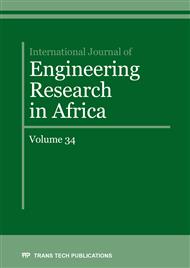[1]
M. R. Bangi, and T. Horiguchi, , Pore pressure development in hybrid fibre-reinforced high strength concrete at elevated temperatures, Cement Concrete Res., 41, (2011) 1150-1156.
DOI: 10.1016/j.cemconres.2011.07.001
Google Scholar
[2]
B. Zhang, M. Cullen and T. Kilpatrick, Effects of thermal and hygric gradients on the spalling of high performance concrete subjected to elevated temperatures, The 2013 Internatianl Conference on Computational Technologies in Concrete Structures, 8-12 September 2013, Jeju, Korea.
DOI: 10.12989/acc.2016.4.1.001
Google Scholar
[3]
M. Kanema Influence des paramètres de formulation sur le comportement à haute température des bétons, Thèse de Doctorat, Génie civil, Université de Cergy-Pontoise, (2007).
DOI: 10.1080/17747120.2006.9692891
Google Scholar
[4]
G. I. Hager Comportement à haute température des bétons à hautes performances - évolution des principales propriétés mécaniques", Thèse de doctorat, Structures et Matériaux, École Nationale des Ponts et Chaussées et l, École Polytechnique de Cracovie, (2004).
DOI: 10.4000/trajectoires.574
Google Scholar
[5]
J. C. Mindeguia Contribution expérimentale à la compréhension des risques d'instabilité thermique des bétons. ", Thèse de Doctorat, Génie Civil, Université de Pau et des Pays de l, Adour, (2009).
DOI: 10.3166/regc.9.373-383
Google Scholar
[6]
Z. Xing Influence de la nature minéralogique des granulats sur leur comportement et celui du béton à haute température, Thèse de Doctorat, Génie Civil, Université de Cergy-Pontoise, (2011).
DOI: 10.1080/12795119.2003.9692502
Google Scholar
[7]
P. Pliya Contribution des fibres de polypropylène et métalliques à l'amélioration du comportement du béton soumis à une température élevée, Thèse de Doctorat, Génie civil, Université de Cergy-Pontoise, (2010).
DOI: 10.3166/ejece.13.71-90
Google Scholar
[8]
A. Amol, H. S. Patila, A. Chore and P. A. Dodeb Effect of curing condition on strength of geopolymer concrete,. Advances in Concrete Construction, (2014), 29-37 DOI: http: /dx. doi. org/10. 12989/acc. 2014. 2. 1. 029.
DOI: 10.12989/acc.2014.2.1.029
Google Scholar
[9]
NF EN 197-1 Ciment partie 1: Composition, spécifications et critères de conformité des ciments courants, (2001).
Google Scholar
[10]
B. Lothenbach, F. Winnefeld and R. Figi The influence of superplasticizers on the refuel of Portland cement, 12th International Congress on the Chemistry of Cement, Montreal, Canada, July 8-13, (2007).
Google Scholar
[11]
Y. Malier, Les bétons à hautes performances: caractérisation, durabilité, application": Presse De l, ENPC, Paris, (1992).
Google Scholar
[12]
P. C. Aîtcin L'interaction ciment/superplastifiants: cas des polysulfonate, Bulletin des Laboratoires des Ponts et Chaussées, (2001).
Google Scholar
[13]
P. K. Chang An approach to optimizing mix design for properties of high-performance concrete, Cem. and Conc. Res., 34 (4), (2004), 623-629.
Google Scholar
[14]
P. C. Aïtcin Developments in the application of high-performance concrete, Construction and Building Materials, 9 (1), (1995), 13-17.
Google Scholar
[15]
NF EN 206-1 Béton partie 1: Spécifications, performances, production et conformité, (2004).
Google Scholar
[16]
C. Castillo Effect of transient high temperature in high strength concrete, Master of Science, Rice University, (1987).
Google Scholar
[17]
P. Pimienta Le comportement au feu des BHP, Synthèse des travaux du projet national BHP 2000 sur les bétons à hautes performances", Paris, Ed. Presses de l, École Nationale des Ponts et Chaussées, (2005).
DOI: 10.4000/histoire-cnrs.435
Google Scholar
[18]
W. P. S. Dias, G. A. Khoury and P. J. E. Sullivan Mechanical properties of hardened cement paste exposed to temperatures up to 700c (1292f), ACI Materials Journal, 87(2), (1990), 160-166.
DOI: 10.14359/1981
Google Scholar
[19]
A. Behnood and Mr. Ghandehari. Comparison of compressive and splitting high tensile strength strength of high-strength concrete with and without polypropylene fibers heated to high temperatures, Fire Safety Journal, 44(8), (2009), 1015-1022.
DOI: 10.1016/j.firesaf.2009.07.001
Google Scholar
[20]
C. Qian Li and W. Sun Mechanical properties of high-strength concrete after fire, Cement and Concrete Research, 34(6), (2004), 1001-1005.
DOI: 10.1016/j.cemconres.2003.11.007
Google Scholar
[21]
A. Noumowé Effet de hautes températures (20- 600°C) sur le béton. Cas particulier du béton à hautes performances,. Thèse de Doctorat, Génie civil, Institut National des Sciences Appliquées de Lyon France, (1995).
DOI: 10.1080/12795119.2002.9692366
Google Scholar
[22]
A. Kanellopoulos, F. A. Farhat, D. Nicolaides and B. L. Karihaloo, Effect of elevated temperatures on the residual mechanical properties of high-performance mortar, Cement Concrete Res., 39, (2009) 1087-1094.
DOI: 10.1016/j.cemconres.2009.07.008
Google Scholar


